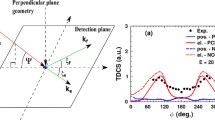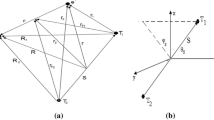Abstract
Positronium formation in Rydberg states from the ground state of the hydrogen atom by positron impact has been studied within the framework of a distorted wave theory which includes static dipole polarization potential. The distorted wave scattering amplitude has been obtained in a closed form. A detailed investigation has been made on the differential and total cross sections in the energy range 25–300 eV of incident positron. It has been found that asymptotic cross sections for the positronium formation into different angular momentum states obey a simple law.




Similar content being viewed by others
References
J P Marler et al. Phys. Plasmas 16 057101 (2009)
T C Naginey, B B Pollock, E W Stacy, H R J Walters and C T Whelan Phys. Rev. A 89 012708 (2014)
T Pohl, T Pattard and J M Rost Phys. Rev. A 68 010703 (2003)
M Leventhal Astrophys. J. 183 L147 (1973)
C J Crannell, R Ramaty and C Werntz 14th International Cosmic Ray Conference (West Germany, Munich:Max-Planck-Institut fur extraterrestrische Physik) 5 1656 (1975)
R W Bussard, R Ramaty and R J Drachman Astrophys. J. 228 928 (1979)
F W Stecker Astrophys. Space Sci. 3 579 (1969)
N N Mondal Int. J. Astron. Astrophys. 4 620 (2014)
N Guessoum, R Ramaty and R E Lingenfelter Astrophys. J. 378 170 (1991)
R Ferragut et al. J. Phys Conf. Ser. 225 012007 (2010)
S Shindo and A Ishii Phys. Rev. B 35 8360 (1987)
A Ishii Phys. Rev. B 36 1853 (1987)
C Consolati, D Franco and D Trezzi Mater. Sci. Forum 733 306 (2013)
T Hirade Mater. Sci. Forum 607 232 (2009)
T Goworek, B Jasinska, J Wawryszczuk and K Ciesielski J. Chem. Soc. Faraday Trans. 93 1573 (1997)
M Doser et al. (AEGIS Collaboration) Class. Quantum Grav. 29 184009 (2012)
G Consolati et al.Chem. Soc. Rev. 42 3821 (2013)
E R Carlson Bull. Am. Phys. Soc. 18 1512 (1973)
S L Verghese, E S Ensberg, V M Hughes, I Lindgren Phys. Lett. A 49 415 (1974)
K F Canter, A P Mills and S Berko Phys. Rev. Lett. 33 7 (1974); 34 177 (1975)
A P Mills, S Berko and K F Canter Phys. Rev. Lett 34 1541 (1975)
S Zhou, H Li, W E Kauppila, C K Kwan and T S Stein Phys. Rev. A 55 361 (1997)
M Weber, A Hofmann, W Raith, W Sperber, F Jacobsen and K G Lynn Hyperf. Interact. 89 221 (1994)
P Mandal, S Guha and N C Sil J. Phys. B 12 2913 (1979)
K Ratnavelu and K K Rajagopal J. Phys. B, 32 L381 (1999)
S Tripathi, C Sinha and N C Sil Phys. Rev. A 39 2924 (1989)
P Mandal and S Guha J. Phys. B 12 1603 (1979)
R Shakeshaft and J M Wadehra Phys. Rev. A 22 968 (1980)
N C Sil, B C Saha, H P Saha and P Mandal Phys. Rev. A 19 655 (1979)
S N Nahar Phys. Rev. A 40 6231 (1989)
A A Kernoghan, D J R Robinson, M T McAlinden and H R J Walters J. Phys. B 29 2089 (1996)
A A Kernoghan, M T McAlinden and H R J Walters J. Phys. B 28 1079 (1995)
J D Jackson and H Shiff Phys. Rev. 89 359 (1953)
D Basu, G Banerji and A S Ghosh Phys. Rev. A 13 1381 (1976)
A S Ghosh, N C Sil and P Mandal Phys. Rep. 87 313 (1982)
R N Hewitt, C J Noble and B H Bransden J. Phys. B 23 4185 (1990)
P Khan, P S Mazumdar and A S Ghosh Phys. Rev. A 31 1405 (1985)
C R Mandal, M Mandal and S C Mukherjee Phys. Rev. A 44 2968 (1991)
M Mukherjee, M Basu and A S Ghosh J. Phys. B 23 757 (1990)
A S Kadyrov and I Bray Phys Rev A 66 012710 (2002)
A S Kadyrov and I Bray J Phys B 33 L635 (2000)
B C Saha and P K Roy Phys. Rev. A 30 2980 (1984)
A Ghoshal and P Mandal Eur. Phys. J. D 46 251 (2008)
S Nayek and A Ghoshal Phys. Plasmas 19 113501 (2012)
A Ghoshal and P Mandal J. Phys. B 41 175203 (2008)
A Ghoshal and P Mandal Phys. Rev. A 72 032714 (2005)
R H Bassel and E Gerjuoy Phys. Rev. 117 749 (1960)
J M Wadehra Can. J. Phys. 60 601 (1982)
L Jiao, Y Wang and Y Zhou Phys. Rev. A 84 052711 (2011)
P Rej and A Ghoshal J. Phys. B 47 015204 (2014)
Acknowledgments
P. Rej sincerely acknowledges the financial support received from University Grants Commission, New Delhi through Junior Research Fellowship. This work is partially supported by UGC Major Research Project (MRP-MAJOR-MATH-2013-8458; F. No. 43-415/2014(SR)).
Author information
Authors and Affiliations
Corresponding author
Appendix
Appendix
Evaluation of the \(1s \rightarrow nlm\) capture amplitude \(g_{B}(\vec {k}_f, \vec {k}_i).\)
The wave function of Ps atom in nlm state is given by
where \(Y_{lm}\) denote the spherical harmonics, and \(L_{n+l}^{2l+1}\) denote the associated Laguerre polynomial of degree \((n+l)\) and order \((2l+1).\)
\(1s \rightarrow nlm\) capture amplitude \(g_{B}(\vec {k}_f, \vec {k}_i)\) is given by
where
We first consider the integral \(I_1\) which contains positron–proton interaction and hence rather difficult to evaluate. Taking Fourier transforms of the function \(exp(-\lambda r)/r\) and then utilizing the \(\delta -\)function properties \(\vec {r}_2\) integration can be carried our easily and we obtain
where \(\gamma _1 = 1/a_0.\) Using integral representation of Feynman
and setting \(\lambda ^2 = A^2x(1-x) + \gamma _{1}^2 x \) we obtain
or,
or,
or,
where
Using the expansion formula of plane wave in terms of spherical Bessel’s function \(J_L,\) such as \(exp(i\vec {p}.\vec {r}_1) = 4\pi \sum _{L,M} i^L j_L(pr_1)Y_{LM}^*(\hat{p}) Y_{LM}(\hat{r}_1),\) and then utilizing the orthogonal property of spherical harmonics \(Y_{LM}\) we obtain
Now using the expansion formula of the associated Laguerre polynomial and a typical integral involving spherical Bessel function, such as
and
we finally obtain
where
Substituting (Eq. (16)) into (Eq. (12)) we obtain
In the similar fashion the integral \(I_2\) can be evaluated. The one-dimensional integration over [0, 1] appearing in integral (Eq. (17)) has been evaluated numerically by employing Gauss–Legendre quadrature formula. Note that the integral (Eq. (17)) has a fictitious singularity , which has been removed by taking a transformation of the form \(x=z^2.\)
Rights and permissions
About this article
Cite this article
Rej, P., Ghoshal, A. Asymptotic cross section and scaling law: positronium formation in Rydberg states in positron–hydrogen collisions. Indian J Phys 90, 749–757 (2016). https://doi.org/10.1007/s12648-015-0811-8
Received:
Accepted:
Published:
Issue Date:
DOI: https://doi.org/10.1007/s12648-015-0811-8




